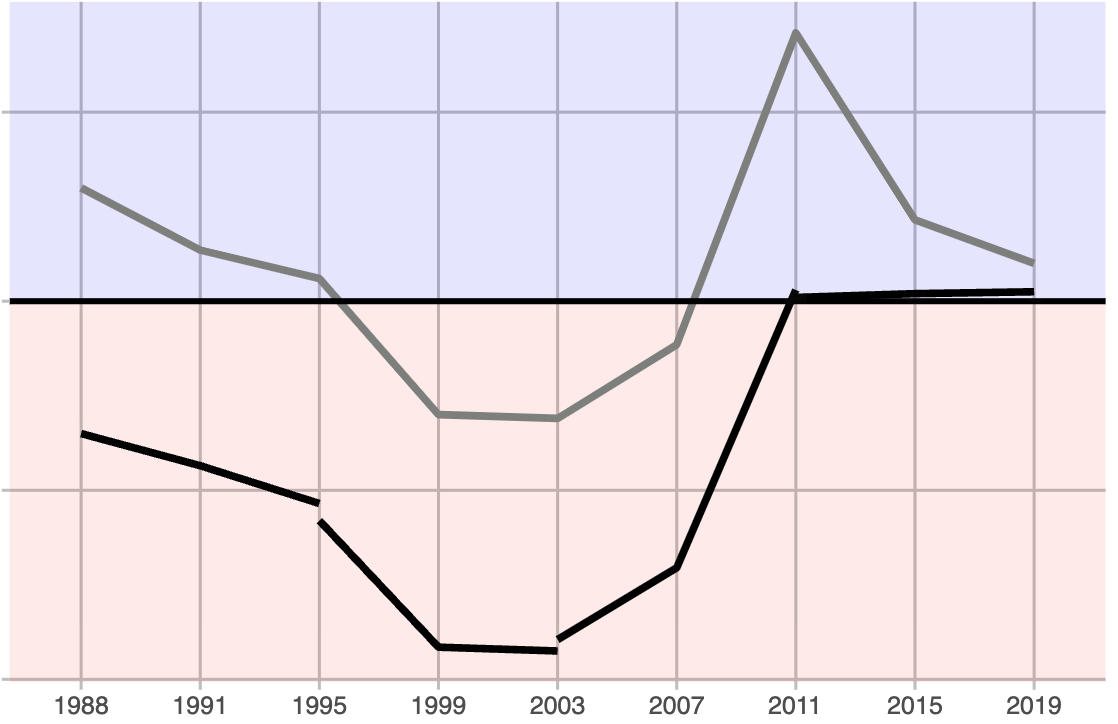I’ve recently finished adding a new feature to my seat guides for the Victorian and New South Wales state elections and I wanted to mention it.
During the federal election, I produced charts showing how the two-party-preferred vote in each seat has shifted in each electorate over the last four decades, comparing the seat’s margin to the state two-party-preferred vote.
I’ve now done something similar for these two state elections.
Unfortunately they’re missing one feature I included in the federal guides. For those guides, I calculated an estimate of the two-party-preferred vote adjusted to the 2022 boundaries for all elections from 2004 onwards, but the necessary data is not publicly available for state elections.
All the same, the charts still give you a sense of how a seat has shifted relative to the state over time. The chart also makes it clear when an electorate’s margin has been shifted by a redistribution.
I’ve posted a chart on almost every individual seat guide. A small number are currently freely available for everyone, but you can access the full guides with a Patreon subscription of $5 or more per month.
I wanted to pick a few examples to feature here.
First up is Mordialloc, a Labor seat in south-eastern Melbourne.
Mordialloc used to be a key marginal seat, with a margin of less than 5% at every election from 1996 until 2014. From 1992 until 2006 the seat leaned to the right of the state, but was pretty much exactly on the state average from 2006 until 2014.
But in 2018, the seat swung even harder to Labor than the state overall, leaving the sitting MP with a 12.9% margin (13.4% after the recent redistribution).
Next up, let’s check out Melton in the outer western suburbs of Melbourne. It has traditionally been a safe Labor seat but became a lot more marginal in 2018.
This seat was won by Labor by a margin of over 10% at every election from 1992 until 2014, despite being drawn as a more marginal seat prior to the 2002 election. But in 2018, while the state swung strongly to Labor, a swing of almost 7% turned Melton into a marginal seat.
I think these charts are actually more interesting in New South Wales, due to the massive swing to the Coalition in 2011. When that swing subsided in 2015, it didn’t leave the electoral landscape the same as it had found it.
Let’s start with my home seat of Parramatta, which Geoff Lee retained for a third term by a 10.6% margin in 2019. The redistribution has cut his margin to just 6.3%, and he’s announced his retirement.
The seat leaned towards Labor from 1988 until 2007, quite significantly in the 1999-2007 period.
The swing to Liberal was huge in 2011, although Parramatta was still slightly to the left of the state. But when the state swung back in 2015, Lee slightly increased his margin, and only suffered a small swing in 2019.
I suspect this partly reflects the value of personal vote, and it seems quite plausible that Parramatta will reassert itself as a Labor-leaning seat in 2023, particularly with the recent redistribution change which is not yet reflected in the chart. The seat hasn’t seen significant redistribution changes during the period in which the seat shifted from Labor-leaning to Liberal-leaning, although a redistribution in 1999 did make it more Liberal-friendly.
Interestingly, I saw similar trends in Riverstone and Ryde, other former Labor seats where a longstanding Liberal MP is retiring.
Finally, let’s check out East Hills, the most marginal Liberal seat in the state.
The seat was Labor-held from 1988 until 2007, and in 2011 the seat swung roughly in line with statewide trends, and was narrowly won by the Liberal Party.
The pre-2015 redistribution made the seat even more marginal, but when the state swung back in 2015 and 2019, East Hills did not.
East Hills still leans to the left, and I suspect it will go to Labor if they are on track to win in 2023, but the seat is much closer to the state median than it was in past decades.




The 2018 2PP in the above graph should be taken with a grain of salt because of the high informal vote (10.06%), in the Assembly, the 12 candidates who ran in Melton (likely the main factor in the informal vote), there being 2,204 fewer informal votes in the Legislative Council in Melton and there being 5,013 more ALP primary vote in the Legislative Council. I suspect 2-4% of the 2PP swing against the ALP was actually a swing to informal.
Comments are closed.